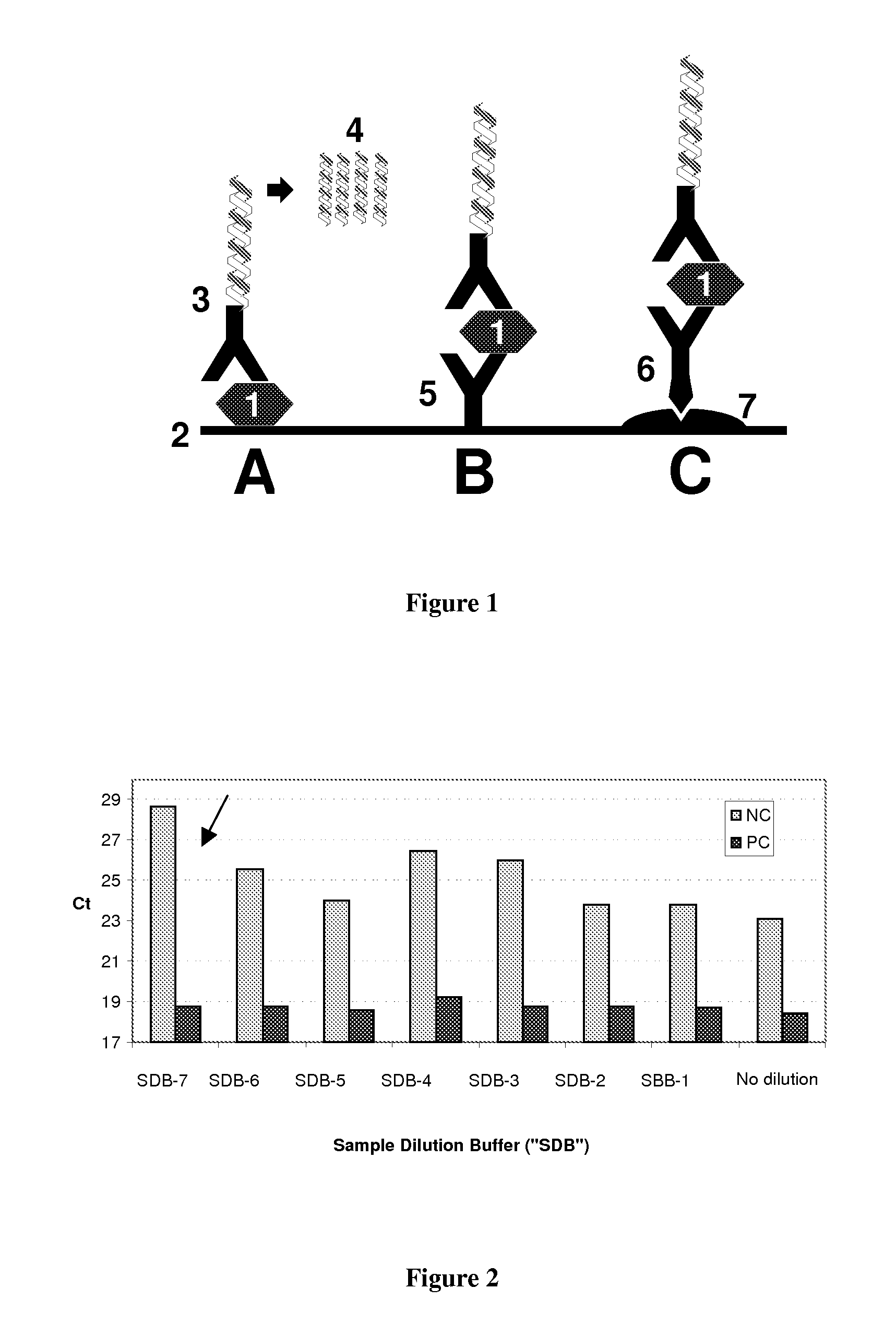Method for the detection of an analyte in biological matrix
a biological matrix and analyte technology, applied in the field of immunopcr (polymerase chain reaction) technique, can solve the problems of limiting the usefulness of this kind of assay, unable to apply methods to biological samples, and unable to perform sandwich assays with capture antibodies, so as to improve the performance of ipcr assay, improve the signal-to-background ratio, and improve the effect of ipcr assay performan
- Summary
- Abstract
- Description
- Claims
- Application Information
AI Technical Summary
Benefits of technology
Problems solved by technology
Method used
Image
Examples
example 1
Sandwich Detection of Several Antigens from Different Biological Matrices Including the Application of Different Sample Dilution Buffers
[0175]Microtiter modules (“TopYield”, cat.-no. 248909, NUNC, Wiesbaden, Germany) were coated with 30 μl / well of target-antigen specific capture antibody in coating buffer (cat.-no. 23-002, Chimera Biotec, Dortmund, Germany). An overview of target antigens, capture antibody and detection conjugates (Antibody-DNA conjugates) as well as the working concentrations of the capture antibodies is given in Table 1. Immobilization was carried out overnight at 4° C., the modules were subsequently washed three times with 240 μl / well buffer A (cat.-no. 23-004, Chimera, Dortmund, Germany) and blocked overnight with 240 μl / well of a blocking solution containing 150 mM NaCl, 20 mM Tris, 4.5% Skim milk powder (Oxoid), 1 mg / ml DNA MB-grade (Roche), 5 mM EDTA (Sigma). On the following day, the modules were washed four times with buffer B (cat.-no. 23-005, Chimera) and...
example 2
Direct Detection of an Antigen from a Matrix Containing Compounds Which Inhibit Binding by Dilution in a Sample Dilution Buffer
[0179]In this experiment, the target antigen rabbit-IgG was spiked as a positive control (5 ng / ml) in a cell lysate buffer containing 1.5 mg / ml plant cell homogenate protein in TBS buffer, 1% SDS and 1 mM DTT. The spiked buffer was either incubated directly in TopYield modules or diluted in various dilution ratios in a sample dilution buffer (“SDB 7”) containing TBS / pH 7.4 / 20 mM Tris / HCl / 5 mM EDTA / 0.09% Tween 20, 2.5% Skim milk powder (LP0031, Oxoid), 0.5 mg / ml DNA (MB grade, cat.-no. 114671490001, Roche, Mannheim) previous to incubation. Immobilization of the target antigen solutions was carried out overnight at 4° C. with an assay volume of 30 l / well, additionally, a sample of the cell lysate buffer without target antigen was incubated in similar dilutions as a negative control. Subsequently, the modules were blocked, incubated with detection conjugate (CH...
example 3
Highly Sensitive Sandwich Detection of an Antigen from a Biological Matrix by Utilization of the DNA-Containing Sample Dilution Buffer
[0181]The evaluate the absolute sensitivity of the improved IPCR assay using sample dilution buffer (“SDB”), a dilution series of IL6 spiked in human serum was prepared and quantified according to the assay protocol as described in example 1, including a 1+1 dilution of the spiked samples in SDB 7. In parallel, a conventional ELISA was carried out, using a biotinylated anti-IL6 detection antibody (R&D Systems) in a working concentration of 200 ng / ml according to manufacturer's instruction. Following a standard washing step, the biotinylated antibody was coupled with a streptavidin / alkaline-phosphatase conjugate, diluted 1:5000 in TBS. Following a final washing step, detection was carried out using the sensitive fluorescence substrate AttopHos (Roche) and a multilabel counter.
[0182]Results are shown in Table 7: As obvious from the date, ELISA detection...
PUM
| Property | Measurement | Unit |
|---|---|---|
| Concentration | aaaaa | aaaaa |
| Concentration | aaaaa | aaaaa |
| Fraction | aaaaa | aaaaa |
Abstract
Description
Claims
Application Information
 Login to View More
Login to View More - R&D
- Intellectual Property
- Life Sciences
- Materials
- Tech Scout
- Unparalleled Data Quality
- Higher Quality Content
- 60% Fewer Hallucinations
Browse by: Latest US Patents, China's latest patents, Technical Efficacy Thesaurus, Application Domain, Technology Topic, Popular Technical Reports.
© 2025 PatSnap. All rights reserved.Legal|Privacy policy|Modern Slavery Act Transparency Statement|Sitemap|About US| Contact US: help@patsnap.com


